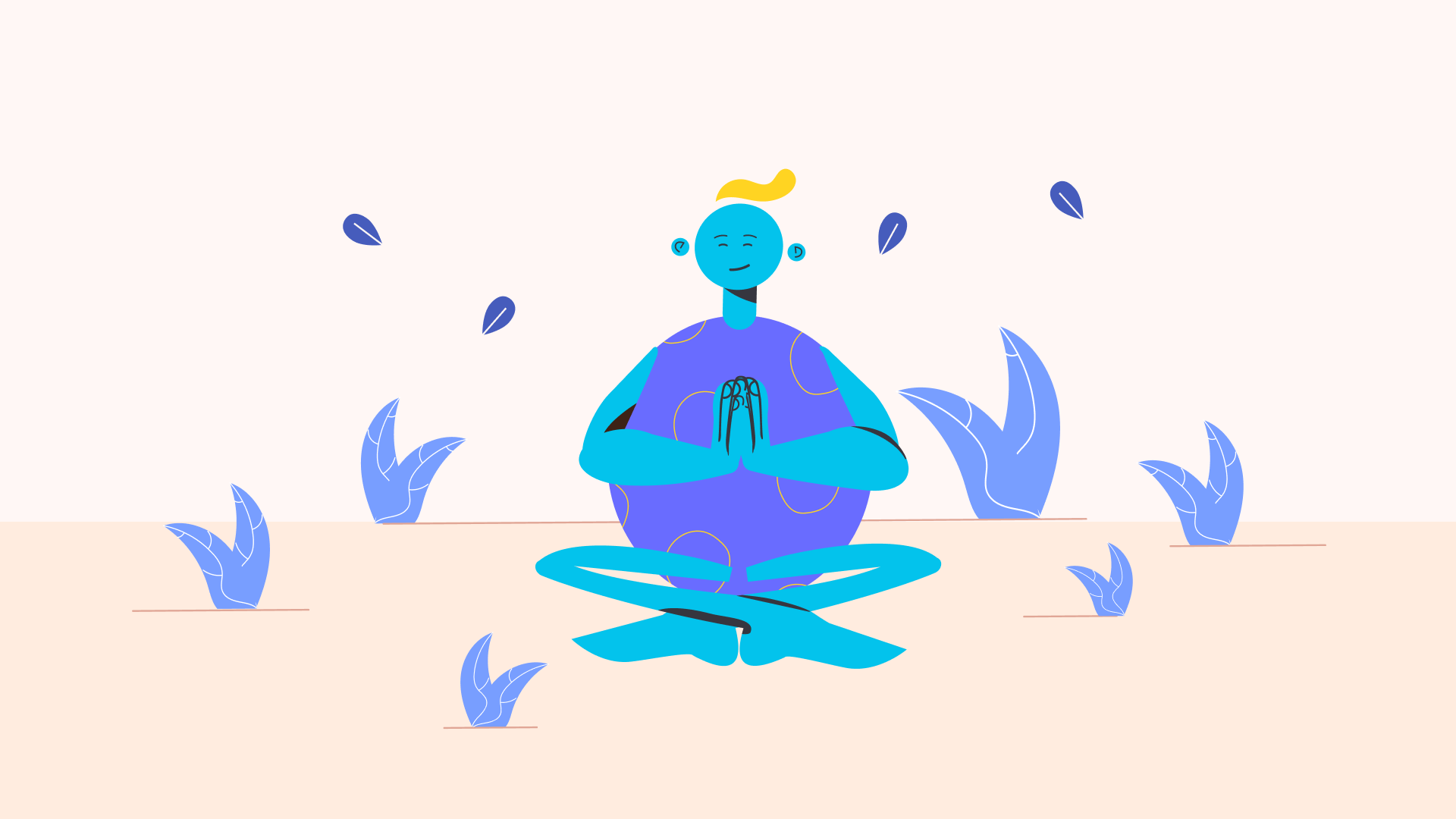
Mentale Gesundheit
26. März 2020 — 5 Minuten Lesezeit
Entspannungsübungen wirken nachweislich beruhigend auf das Nervensystem

Entspannungsübungen wirken nachweislich beruhigend auf das Nervensystem. Insbesondere bei Angststörungen sind sie somit hilfreich, um Anspannung und Nervosität zu senken. Das wiederum führt dazu, dass es zu insgesamt weniger Angstattacken kommt. Wenn es dennoch zu einer Angstattacke kommt, helfen sie deinem Körper dabei, sich anschließend schneller wieder zu regulieren. Entspannungsübungen bieten somit eine gute Unterstützung auf deinem Weg aus der Angst. Eine Übersicht über wissenschaftlich anerkannte Entspannungsübungen zur Reduktion von Angst und Panik findest du in diesem Artikel.
Vor etwa 100 Jahren entdeckte der Arzt Edmund Jacobson, dass psychisch Erkrankte zusätzlich unter Muskelverspannungen und körperlichen Anspannungs- und Erregungszuständen leiden. Um dem entgegen zu wirken, entwickelte er die Progressive Muskelentspannung (PME), auch Progressive Muskelrelaxion (PMR) genannt.
Bei der Progressiven Muskelentspannung spannen wir verschiedene Muskelgruppen in bestimmter Reihenfolge nacheinander gezielt an, halten die Anspannung für wenige Sekunden und lösen diese dann wieder. Dadurch lernen wir bewusst Unterschiede zwischen An- und Entspannung wahrzunehmen und somit die Entspannung aktiv selbst herbei zu führen. Progressiv heißt fortschreitend. Zum einen bedeutet es, progressiv mehr und mehr Muskelgruppen in die Übungen zu integrieren. Zum anderen über die Zeit, bestimmte Muskelgruppen als zusammengehörig wahrzunehmen und aktiv loszulassen. Langfristig wirkt sich das nicht nur entspannend auf unseren Körper, sondern auch auf unsere Psyche aus. Also eine wirklich effektive Entspannungstechnik für jeden, der nicht ausschließlich liegen, sondern auch aktiv dabei sein möchte.
Das Autogene Training ist eine Entspannungstechnik, die sich am besten als eine Art Selbsthypnose begreifen lässt. Ziel ist es, durch gedankliche Konzentration auf den Körper eine Entspannung von innen heraus zu bilden. Wir konzentrieren uns dabei insbesondere auf die Ruhe, Schwere und Wärme in unserem Körper. Dies wird nacheinander aufgebaut und drei Mal hintereinander durchgesprochen. Das klingt in Gedanken ausgesprochen meist so: Mein linkes Bein ist ganz warm und schwer. Durch diese sogenannten Autosuggestionen wird das Unterbewusstsein aktiviert, Einfluss auf den Körper zu nehmen.
Wenn wir Stress in unserem Alltag reduzieren, nehmen wir auch unserer Angst etwas von ihrem Nährboden weg. Die von Jon Kabat-Zinn entwickelte Entspannungstechnik MBSR lehrt uns, wie wir unsere Aufmerksamkeit lenken und achtsamer durch den Alltag gehen können. Das erlernen wir über verschiedene Übungen zur Körperwahrnehmung (z.B. Body-Scan), Atem-, Yoga- und Meditationsübungen. Es geht vor allen Dingen darum, ohne Wertung den Augenblick wahrzunehmen.
Durch Biofeedback können wir lernen, unbewusst ablaufende Vorgänge im Körper wahrzunehmen und diese gezielt zu beeinflussen. Das können der Herzschlag, Puls oder auch Hirnströme sein. Dabei werden wir an medizin-technische Geräte angeschlossen, die diese Vorgänge messen und über visuelle Signale oder Geräusche direkt für uns erlebbar machen. Ziel ist es, durch Atmung oder Entspannung diese Vorgänge positiv zu beeinflussen und durch das Feedback (z.B. ein grünes Licht) zu lernen, wann und durch welches Verhalten der entspannte Zustand eintritt. Durch Übung lernen wir, diesen Zustand auch ohne technische Geräte herbeizuführen.
Im klassischen Sinne ist Sport keine Entspannungsübung, aber dafür eine hilfreiche Methode, um Stresshormone schnell abzubauen. Denn aufgrund von Angstzuständen setzt der Körper mehr Stresshormone frei. Sport bringt den Körper nicht nur dazu, Stresshormone auszuschwitzen, sondern setzt auch das Glückshormon Endorphin frei. Endorphine sorgen dafür, dass wir uns in unserer Haut entspannt und wohl fühlen. Das wiederum erlaubt uns, einen kühleren Kopf zu bewahren, wenn wir ängstlich sind oder Panikattacken aufkommen. Vor allem Ausdauersportarten haben sich als wirksam erwiesen, um Angstsymptome zu reduzieren. 30 Minuten am Tag reichen bereits aus.
Nicht nur Ausdauersport, sondern auch Meditation und meditative Sportarten gelten als wissenschaftlich anerkannte Methoden, um Anspannung und Angst zu reduzieren. Dazu gehören unter anderem Tai Chi, Qigong und Yoga.
Meditation wirkt sich laut Studien direkt auf Hirnareale aus, die unsere Gefühle regulieren. Dabei geht es nicht, wie oft angenommen wird, darum „an nichts zu denken“, sondern aufkommende Gedanken zuzulassen, sie wahrzunehmen, sie jedoch nicht zu bewerten und somit vorüber ziehen zu lassen. Man übt, im Moment präsent zu sein und seine Umwelt bewusst wahrzunehmen.
Tai Chi und Qigong gelten als traditionelle chinesische Bewegungskünste. Beide beinhalten fließende, bedachte Bewegungsabläufe, die Entspannung und Konzentration fördern sowie die Körperenergien zum Fließen bringen. Qigong ist Teil der Traditionell Chinesischen Medizin (TCM) und verfolgt durch die Aktivierung der Selbstheilungskräfte ein gesundheitliches Ziel. Tai Chi hingegen gehört den Kampfkünsten an und ist in der Ausführung dynamischer als Qigong.
Yoga beinhaltet ganzheitliche Körperübungen, welche die Muskulatur kräftigen, dehnen und entspannen. Das wirkt sich unter anderem gesund auf das Herz-Kreislauf-System aus, senkt Stresshormone und reduziert Ängste. Beim Yoga wird zusätzlich ein verstärkter Fokus auf Atemtechniken (Pranayama) gelegt. Pranayama verringern wissenschaftlich erwiesen Ängste, indem sie direkt beruhigend auf das Nervensystem wirken.
Hier eine kleine Faustregel für beruhigendes Atmen: Atme doppelt so lang aus, wie du einatmest.
Angst wird von einer flachen Atmung und Herzrasen begleitet. Durch den Atem können wir direkten Einfluss auf unsere Herzfrequenz nehmen. Das nächste Mal wenn Angst aufkommt, versuche möglichst sanft durch die Nase einzuatmen und durch einen minimal geöffneten Mund doppelt so lange auszuatmen. Dabei darf ruhig ein pfff-Geräusch entstehen. Achte darauf, dass du deine gesamte Luft ausatmest. Wenn du es schaffst, pausiere die Atmung dann für einen kurzen Moment ganz, bevor du wieder sanft einatmest. Schon nach ein paar solcher Atemzügen wirst du merken, wie dein Herzschlag deutlich ruhiger wird und sich dein Körper entspannt.
Um erste Veränderungen wahrzunehmen und auch langfristige Entspannungserfolge zu verzeichnen, ist es wichtig, regelmäßig über einen längeren Zeitraum zu üben. Neben Kursangeboten vor Ort gibt es viele freizugängliche Online-Angebote. Einfach mal bei der Suchmaschine, dem App Store oder Video- und Streamingportal deines Vertrauens die jeweilige Entspannungsmethode eingeben. Manche Entspannungsverfahren werden auch von den Krankenkassen gefördert und bezuschusst. Über individuelle Angebote bei Entspannungstechniken erkundigst du dich am besten direkt bei deiner Krankenkasse.
Wichtig: Entspannungsübungen sollten nicht angewandt werden, wenn du dich gerade in einer akuten Panikattacke befindest oder eine Konfrontationsübung machst!